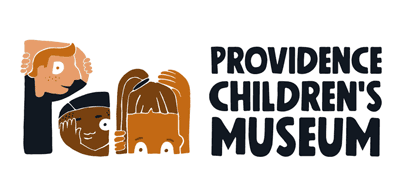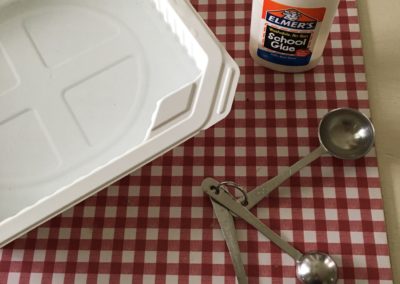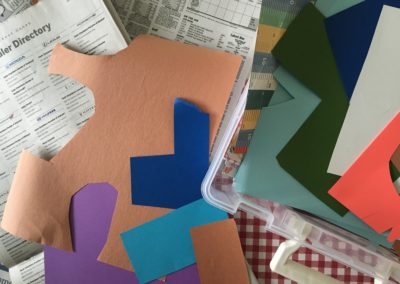Making Paper
Developed by Jessica M. Iiams, PCM Play Intensive 2021
(FOCUS: PreK-3, STEM, Creativity & Making)
Did you know that approximately 815 million trees get cut down each year for the production of paper products? As stewards of the Earth, we need to work together to lower that number. This lesson helps students understand that the Earth’s natural resources are limited and need to be protected and conserved. In the activity, students will learn the process of paper-making by using recycled paper and household materials to create new paper.
New vocabulary to learn:
Deforestation: when forests are completely cleared out by cutting trees down for product production or fuel
Pulp (for paper-making): the substance created by blending the recycled paper and water
Screen: used to collect the surry from a vat in paper-making; in this case, the screen is a coat hanger and nylon material.
Slurry: mixture of water, glue, and paper pulp
Vat: container (dishpan) used to hold the slurry
Materials
- Nylons pantyhose with legs (one leg per child)
- Blender
- Wire clothes hangers (one per child if you are doing the activity together)
- Plastic tub (such as a dishpan bin)
- Tablespoon
- Newspapers and other recycled (thin) paper
- White glue
- Paper towels
- Items to make your paper fancy such as flower petals or leaves
Set Up
Work on a sturdy flat surface that is at the child’s height. You will also need to be near an outlet to work the blender and a water source.
Prepare an area (preferably outside) that has plenty of warm sunlight where you can leave your paper to dry without being disturbed.
*It is important to note that if you are doing this activity with your whole class at the same time, you will need a screen, which is the wire coat hanger and stretched nylon, for each student. You can reuse the screen, but it takes at least a day for the paper to be completely dry and able to be removed. I make one screen for each child so they can reuse it to make more and more paper!
Student’s Job
Think about how are our paper products are made. Where does paper come from? How can we recycle our old newspapers and art paper to help reduce our use of the natural resource?
The students will contribute to a discussion on how humans can reduce, re-use, and recycle paper products to conserve our trees and assist in the production of recycled paper.
Steps:
- Tear up old paper and add it to the blender with water to make pulp.
- Prepare the vat (dishpan) with water and two tablespoons of white glue.
- With assistance, prepare the screen by bending the wire clothes hanger into a rhombus (sort of diamond shape) and stretching the pantyhose over it tying a knot at each end.
- Pour the pulp mixture into the vat and mix it up well to create the slurry. Next, use the screen to collect the pulp by dipping it to the bottom of the vat and slowly lifting it back up gently shaking it back and forth to evenly distribute the slurry. Let the excess water drain off and then transfer it to a stack of paper towels. Also place a stack of paper towels on the top to soak up more of the water. Note: Allow the paper towels to dry and reuse them for more paper making or other household use.
- Put the screen outside in the hot sun or in a sunny window until the new paper is completely dried. Carefully remove the paper from the screen and you will have a brand-new sheet of useable paper.
Further Challenges:
Continue to collect old paper products to make new paper. Try adding scents to your paper with natural oils or add flower petals or leaves that you find on the ground to the slurry before you dip your screen to make your paper fancy!
Teacher’s Job
As the teacher, your first job is to lead a discussion on the importance of conserving our forests and other natural resources. You may want to read a story such as Lynne Cherry’s The Great Kapok Tree or watch a YouTube video like “Save Our Planet” by Smile and Learn,
During the paper-making process, you should assist and facilitate only as much as needed to keep the student safe. Use the paper-making vocabulary while creating and ask thought provoking questions about the process: “How did the paper change once we put It In the water?”, “Why do you think we need to add glue to the slurry?”, etc.
After the paper-making process is completed, have a discussion about the steps of making paper: “Was it easy to make the one piece of paper?”, “How do companies make billions of pieces at a time?”, “How do paper-making factories further hurt our planet?”, “What can we do to prevent so much destruction to our world?”, etc.
Standards Alignment
RI EARLY LEARNING AND DEVELOPMENT STANDARDS: SCIENCE
COMPONENT 1: SCIENTIFIC INQUIRY AND APPLICATION
Children learn to plan for and carry out investigations and collect, evaluate, and communicate information.
COMPONENT 2: KNOWLEDGE OF SCIENCE CONCEPTS
Children explore the characteristics of objects and materials that are living, non-living, man-made, or naturally occurring.
NEXT GENERATION SCIENCE STANDARDS: EARTH’S SYSTEMS
K-ESS2-2: Conduct an argument supported by evidence for how plants and animals (including humans) can change the environment to meet their needs.
NEXT GENERATION SCIENCE STANDARDS: EARTH AND HUMAN ACTIVITY
K-ESS3-1: Use a model to represent the relationship between the needs of different plants and animals (including humans) and the places they live.
K-ESS3-3: Communicate solutions that will reduce the impact of humans on the land, air, water, and/or other things in the local environment.
Connection to Previous Work?
This lesson connects to the “Focus on K2 Curriculum” Unit 4: Our Earth. It can also be tied to a lesson on community and working together.
Prepare/ Background Info
To prepare for this lesson, you may choose to read or watch The Lorax by Dr. Seuss. You may also play a matching game where students match pictures of objects to the natural resource from which they came.
Facilitation Strategies
Before: Discuss the following ideas:
- What are natural resources and why are they important?
- How do we use wood/trees in our everyday lives?
- How can we conserve trees used to make our paper products?
During: Allow the students to explore and handle the materials by themselves as much as possible, depending on ability. Continue to ask thought-producing questions for further understanding and critical thinking.
After: Discuss the paper-making process pointing out how long it took to make a single sheet of paper. Facilitate a discussion on other ways we could work together as a community to conserve our trees.
For more advanced students you could further the discussion and critical thinking by pointing out that mass producing paper, even when it is recycled paper, uses other natural resources for energy to run equipment.
Play to Notice
If you begin your lesson with a game of matching resources to their products, make sure to notice who is understanding the concepts. Notice the student’s abilities of making the paper. Do they seem ready to make more paper with less adult facilitation?
Content Matter to Notice
Are the students using vocabulary terms learned during discussions? Are the students making connections between the paper-making activity and the natural world they live in? Is the activity sparking more questions?
SEL to Notice
How well are the students working independently with the paper-making? Are they confident in their skills? Are students able to wait their turn to use the materials and are they sharing? Are the students taking turns while speaking and listening to others’ responses?




0 Comments